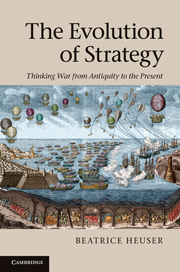Book contents
- Frontmatter
- Contents
- Acknowledgements
- A note on referencing
- Part I Introduction
- PART II Long-term constants
- 2 Warfare and mindsets from Antiquity to the Middle Ages
- 3 Warfare and mindsets in early modern Europe
- 4 Themes in early thinking about Strategy
- PART III The Napoleonic paradigm and Total War
- PART IV Naval and maritime Strategy
- PART V Air Power and nuclear Strategy
- PART VI Asymmetric or ‘small’ wars
- PART VII The quest for new paradigms after the World Wars
- Bibliography
- Index
4 - Themes in early thinking about Strategy
from PART II - Long-term constants
Published online by Cambridge University Press: 05 June 2012
- Frontmatter
- Contents
- Acknowledgements
- A note on referencing
- Part I Introduction
- PART II Long-term constants
- 2 Warfare and mindsets from Antiquity to the Middle Ages
- 3 Warfare and mindsets in early modern Europe
- 4 Themes in early thinking about Strategy
- PART III The Napoleonic paradigm and Total War
- PART IV Naval and maritime Strategy
- PART V Air Power and nuclear Strategy
- PART VI Asymmetric or ‘small’ wars
- PART VII The quest for new paradigms after the World Wars
- Bibliography
- Index
Summary
The profusion of variables in war has never discouraged the search for foolproof systems.
(Galula 1964/2005: xii)There is universality even amidst great diversity. Strategy and strategic effect do not differ from war to war, among geographic environments, or among culturally distinct belligerent polities.
(Gray 1999a: 362)Chapters 2 and 3 have dealt with attitudes to war and its purpose in late Antiquity, the Middle Ages and early modern history, highlighting both changes and continuities. This chapter will dwell on aspects which have partly or entirely continued to the present: the basic pattern of siege warfare; debates about the recruitment and status of troops; the question of the importance of battle as well as defensive and offensive strategies; the spectrum of warfare from limited to major; and the ceaseless quest for eternal principles guiding warfare and ruling war.
Sieges and static defences from Troy to Basra
From Antiquity to the present, territorial conquest has never been achieved by a total physical occupation of all land. Instead, the symbolic seizure of certain settlements and strategically crucial points like mountain passes or bridges or crossroads (frequently coincident with settlements) had and has to make do. In turn, such places would be defended, best done by fortifying them.
- Type
- Chapter
- Information
- The Evolution of StrategyThinking War from Antiquity to the Present, pp. 76 - 110Publisher: Cambridge University PressPrint publication year: 2010



